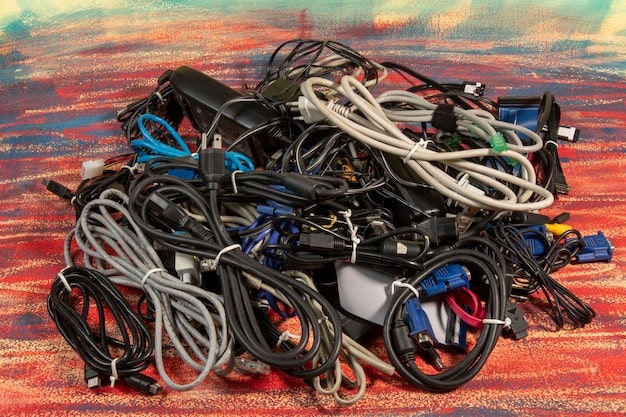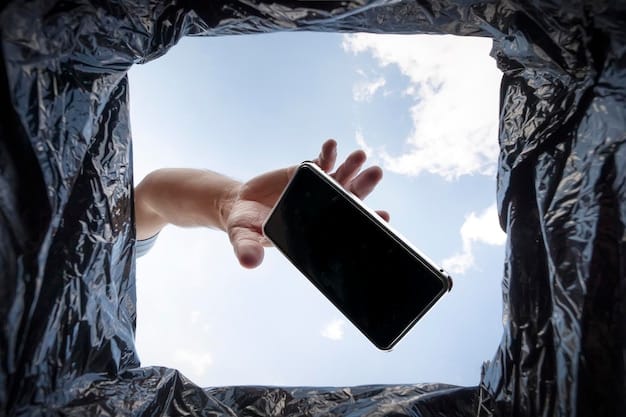FCC Electronic Waste Regulations 2025: Impact on US Consumers

Advertisements
The new FCC regulations on electronic waste recycling in 2025 will impact US consumers by enforcing stricter disposal rules and boosting manufacturer responsibility.
They aim to foster a sustainable circular economy for electronics, possibly affecting product prices and recycling access.
As technology advances, managing the waste it produces becomes more urgent. Understanding how these regulations influence consumer behavior in 2025 is crucial for adapting and promoting responsible disposal.
Advertisements
These measures are set to reshape how electronics are used, maintained, and discarded. The focus is on sustainability, reducing environmental harm, and improving nationwide recycling efficiency.
Understanding the E-Waste Challenge in the US
Electronic waste is one of the fastest-growing waste streams worldwide, with millions of devices discarded annually in the US. This trend is driven by rapid tech advancements and planned obsolescence.
E-waste contains valuable metals like gold and silver, but also hazardous substances such as lead and mercury. In landfills, these can contaminate soil and groundwater, harming ecosystems.
Advertisements
Losing these resources increases demand for raw materials, worsening the environmental impact of electronics manufacturing. Proper disposal is vital for environmental and public health.
The Scale of the Problem
The US generates millions of tons of e-waste yearly, a number that continues to rise. Items range from smartphones and laptops to TVs and large appliances.
Mobile phones are replaced every 18–24 months, computers every 3–5 years, and larger devices are often upgraded. This drives constant waste generation.
The fragmented recycling system and reliance on voluntary efforts cause improper disposal. Stronger regulations and public engagement are needed to address this.
Key Provisions of the New FCC Regulations
The FCC’s role now extends beyond device safety to e-waste management, creating a standardized national framework. This is a significant policy shift.
The regulations emphasize enhanced producer responsibility and uniform consumer guidelines. They recognize the full lifecycle of electronics, from sale to disposal.
By holding manufacturers accountable and simplifying recycling, the FCC seeks to reduce waste, improve efficiency, and protect the environment.
Enhanced Producer Responsibility (EPR)
EPR moves the cost and logistics of recycling from consumers and cities to manufacturers. Companies must fund or operate take-back and recycling programs.
This will drive design changes for durability, repairability, and recyclability. Transparency on materials will also be enforced.
Manufacturers gain a financial reason to reduce waste, leading to innovative materials, modular designs, and longer-lasting products.
Standardized Recycling Guidelines
State-by-state recycling laws create confusion and inefficiency. The FCC aims to unify these rules nationwide.
Consumers will get clear instructions and easier recycling options, such as drop-off points or mail-back programs.
Recyclers benefit from consistent processes, boosting investments in advanced technologies and increasing recycling rates.

Impact on US Consumers: What to Expect in 2025
The regulations will affect electronics purchases, usage, and disposal habits starting in 2025. Prices, convenience, and design may change.
The goal is environmental sustainability, but shifts in consumer behavior are essential for success.
Industry and individuals will need to adapt to foster responsible consumption and disposal practices.
Changes in Product Pricing and Design
EPR costs may raise retail prices slightly, potentially through eco-fees. However, longer-lasting and recyclable products will offer long-term value.
Manufacturers will be motivated to create more durable, repairable devices, using recycled materials where possible.
Consumers could see better-quality electronics designed for easy disassembly and safer recycling.
Accessibility and Convenience of Recycling
Lack of convenient recycling is a major barrier for consumers. The FCC plans to expand and standardize collection systems.
Expect more drop-off points at retail locations, expanded mail-back programs, and convenient pickup services designed to make consumer participation in e-waste recycling effortless.
Easier access to standardized recycling options will significantly boost participation rates, ensuring more electronics are properly processed and reducing improper disposal nationwide.
Data Security and Privacy Concerns
As more devices enter official recycling programs, ensuring the complete protection of stored personal data becomes increasingly vital for consumer safety.
Consumers must back up, reset, or securely wipe devices before disposal. Certified recyclers may offer destruction services.
Stricter recycler protocols will help prevent identity theft and ensure privacy while recycling responsibly.
Challenges and Opportunities for Manufacturers
The upcoming FCC rules on e-waste recycling bring both challenges and opportunities for US manufacturers. They aim to boost sustainability but require operational and financial adjustments.
Manufacturers, from large corporations to startups, must rethink design, production, and end-of-life strategies. This includes investing in R&D and forging new recycling partnerships.
These regulations are not just compliance requirements. They act as a catalyst for systemic industry change, opening paths for innovation and stronger brand reputation.
Adapting to Extended Producer Responsibility (EPR)
EPR holds companies accountable for the full lifecycle of their products, from material sourcing to disposal. This demands major business and design changes.
Manufacturers must prioritize recyclability and repairability, use safer materials, and create modular designs that ease disassembly and reuse.
They may also need to run take-back programs, share recycling costs, and adjust prices. Success will rely on integrating sustainability into core operations.
Innovation in Sustainable Materials and Design
While EPR is challenging, it fuels innovation in sustainable products and processes. This can strengthen competitiveness and brand image.
Opportunities include developing biodegradable materials, reducing rare earth use, and designing components for easy refurbishment and reuse.
Focusing on durability and repairability appeals to eco-conscious consumers. Early adopters of these practices can lead the market and attract responsible investors.
Environmental Benefits and Circular Economy Aspirations
The FCC’s e-waste rules target environmental protection and a circular economy, replacing the unsustainable “take, make, dispose” model.
They aim to reduce hazardous waste, conserve raw materials, and change how society uses and discards electronics.
By promoting responsibility across the supply chain, these regulations set a foundation for lasting environmental and economic benefits.
Reducing Landfill Burden and Hazardous Contamination
Proper e-waste recycling reduces landfill use and prevents toxins like lead and mercury from polluting soil and water.
It also cuts toxic emissions from burning waste and protects biodiversity and human health from harmful chemicals.
By diverting devices to certified recyclers, the rules help preserve ecosystems and improve air and water quality nationwide.
Promoting Resource Conservation and Recovery
Electronics contain valuable materials like gold, silver, and copper, often lost when waste is mishandled.
Recycling recovers these resources efficiently, reducing the need for environmentally damaging mining.
Recovered materials can be reused in manufacturing, supporting a circular economy and boosting resource security.
The Role of Consumers in Successful Implementation
The FCC’s success depends on active consumer participation, not just policy and infrastructure.
Individual actions, from proper disposal to repair and reuse, can collectively drive major environmental benefits.
Engaged consumers give momentum to the regulations, making the transition to a sustainable electronics market possible.
Awareness and Education
A key barrier to e-waste management is limited consumer awareness of hazards and recycling options.
The FCC aims to bridge this gap through education, promoting certified centers and safe disposal practices.
Consumers must learn proper device preparation, data sanitization, and sorting to align with the regulations’ goals.
Embracing Repair and Reuse Culture
The FCC regulations encourage a culture of repair and reuse before recycling. Extending a device’s life can involve repairs, upgrades, donations, or resales.
The “right to repair” movement supports access to repair tools, parts, and guides, cutting e-waste and conserving resources at the source.
By choosing repair and responsible disposal, consumers become active drivers of a sustainable electronics market in the US.
Long-Term Outlook and Future Trends Beyond 2025
The 2025 FCC rules mark progress in e-waste management but are only a step in an evolving landscape.
Regulations will likely adapt to emerging tech, shifting habits, and global standards for better lifecycle management.
A more integrated, global approach will define future policies, emphasizing innovation and environmental responsibility.
Emerging Technologies and Their E-Waste Implications
New tech like wearables and IoT devices uses complex materials and embedded batteries, complicating recycling.
Miniaturization and composites require specialized recovery processes and modular design solutions.
Policymakers must set stricter standards to ensure next-gen devices are recyclable and repairable from the start.
The Circular Economy as a Driving Force
The circular economy focuses on designing products for minimal waste and maximum resource utility.
Models like product-as-a-service, remanufacturing, and repair networks keep materials in circulation longer.
Future rules may push closed-loop systems where recovered materials are reused in new products.
Global Collaboration and Harmonization
E-waste is a global issue, requiring shared standards and cooperation to prevent illegal waste dumping.
International agreements can set common rules for product design, standardized labeling, and consistent recycling practices across all participating countries.
Global efforts create fairness for manufacturers and ensure waste is managed responsibly worldwide.
Benefits for a Greener Tomorrow
The FCC’s 2025 rules aim to reduce waste, protect ecosystems, and conserve resources through recycling.
By redesigning products for durability and repairability, manufacturers can cut environmental impact.
These measures may also create new green jobs, stimulate innovation, and strengthen the domestic economy through sustainable growth.
A Collective Responsibility
Success relies on governments, industries, and consumers working together in a coordinated effort to improve e-waste management.
Manufacturers must invest in innovative sustainable designs and maintain strong, efficient take-back systems nationwide.
Consumers should choose repair, reuse, and informed recycling to balance tech use with environmental care.
| Key Point | Brief Description |
|---|---|
| ♻️ Producer Responsibility | Manufacturers will bear more financial and logistical responsibility for recycling their products, potentially impacting product design and pricing. |
| 📦 Consumer Impact | Consumers may see minor price increases but gain improved access to standardized and convenient recycling options nationwide. |
| 🌍 Environmental Benefits | Regulations aim to reduce landfill waste, prevent hazardous contamination, and promote the recovery of valuable resources for a circular economy. |
| 💡 Innovation & Future | Expect more focus on sustainable material design, repairability, and potentially subscription models to keep electronics in use longer. |
Frequently Asked Questions About FCC E-Waste Regulations
The new FCC regulations are a comprehensive set of rules aimed at improving electronic waste recycling in the US, taking effect in 2025. They expand the FCC’s role beyond device operation to include end-of-life management, emphasizing producer responsibility and standardizing recycling guidelines across states to promote environmental sustainability.
Potentially, yes. Manufacturers may pass on increased costs associated with managing end-of-life products through slightly higher retail prices or an “eco-fee.” However, this could also incentivize more durable, repairable products, potentially leading to long-term savings from extended product lifespans and reduced replacement needs.
The regulations aim to standardize recycling practices and enhance producer responsibility, which should lead to more accessible and convenient recycling options. This could include more widespread drop-off locations, expanded mail-back programs, or clearer instructions on how to properly dispose of various electronic devices in your community from 2025 onwards.
Manufacturers will have enhanced producer responsibility, meaning they will be more accountable for the entire lifecycle of their products. This includes potentially funding or operating take-back programs, designing products for easier recyclability, and providing greater transparency about materials used, pushing for a more circular economy.
With increased recycling, data security is crucial. Always back up your data and perform a factory reset or use specialized data wiping software before recycling any device. Choose certified recyclers who offer secure data destruction services to ensure your personal information is completely erased, protecting your privacy.